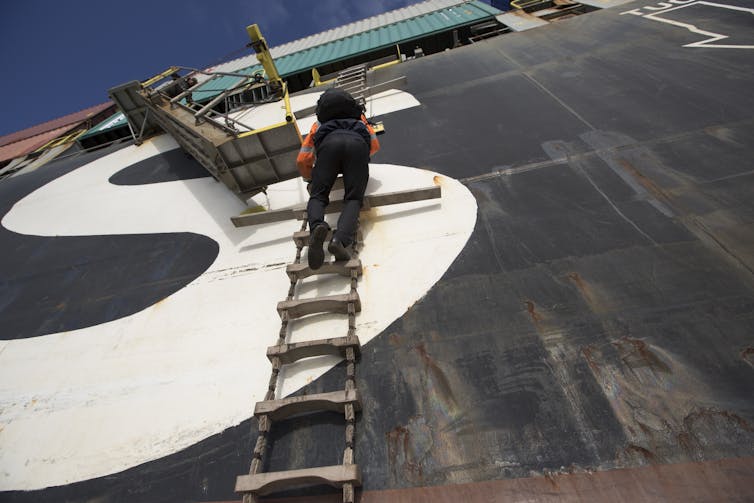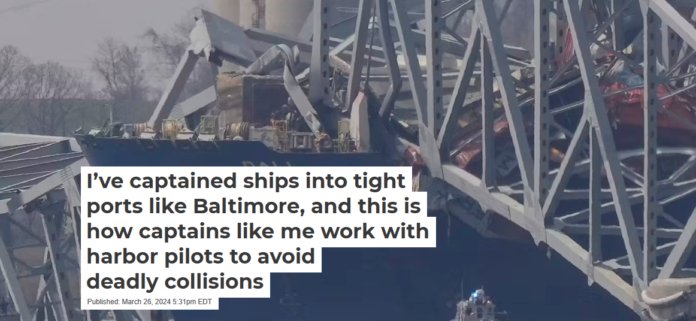
Allan Post, Texas A&M University
Details are still emerging about the disaster that happened in the early morning of March 26, 2024, when the Dali, a large cargo ship on its way out of the port of Baltimore, hit a major bridge and caused it to collapse.
The Conversation’s senior politics and democracy editor, Naomi Schalit, spoke with Captain Allan Post, a veteran ship’s officer, about the role a ship pilot plays in bringing a large ship in and out of a harbor. Post, who now directs Marine Education Support and Safety Operations at Texas A&M University at Galveston and is also deputy superintendent of the Texas A&M Maritime Academy, said the disaster was “absolutely” every crew member’s nightmare.
What was your first thought when you heard about the accident?
Post: My first thought was, thank God it happened at night, because of the low amount of traffic on the bridge. If that had happened during the daytime, casualties would be in the thousands. My heart aches for those lives lost.
There were two ship pilots aboard the ship as it left its berth in the Port of Baltimore. Can you tell us what ship pilots do?
Post: Ship pilots are brought on board in what are considered restricted maneuverability or navigation areas. They are local experts who are usually certified by the state or federal government to provide advice to the master of the vessel as to how to control the vessel, safely and adequately, through the pilotage waters, which in this case would be down the river from the Port of Baltimore.
Pilots are well practiced in close-quarters maneuvering, especially with tugboats and docking the vessel alongside the assigned berth. https://www.youtube.com/embed/YVdVpd-pqcM?wmode=transparent&start=0 The moment the Francis Scott Key Bridge collapsed after a container ship slammed into it.
But a pilot doesn’t come aboard the ship and take control of it, do they?
Post: They are just advisers to the captain, who is known as the “master.” The master still has full responsibility for the safe navigation of the vessel. So the pilot will meet the ship out at sea or at the dock if it’s in port and leaving to go to sea. They proceed up to the bridge. Usually they exchange greetings, and usually a little bit of ship’s swag is given, either a hat or something else, or at least a cup of coffee.
They then set up their gear. With the electronics that we now have, they plug into the ship’s electronic chart data information system. And then they conduct the pilot exchange with the master of the vessel, where the master of the vessel describes where they are going, what the characteristics of the ship are, who’s on the bridge, what their first language is and the air draft of the vessel, which refers to how high out of the water the vessel is, so that you know whether you can take the ship under a bridge safely.
Once that’s completed, the pilot then starts instructing the officer of the watch or the captain – those are usually the same person – in how to get to where they need to be to dock the ship, or undock the ship and bring it to sea. This instructing is done during complex maneuvers, not all the time. The pilot can also say he’s not going to do it, and can shut down their operations if conditions are unsafe or if they feel that the vessel is not in condition to be able to transit safely. That happens a lot, especially in fog.
The ship pilot also interacts with the Coast Guard Vessel Traffic Service and other ships in the area, and coordinates with the tugboats and line handlers to be able to safely maneuver the vessel close to the pier or when a ship is leaving the berth.
Can you describe the training of a ship pilot?
Post: Most of them start out at a maritime academy and have to spend many years at sea in command or as a bridge watch-stander on a vessel. From there, they start into the pilot apprentice program that each one of the pilot associations has, and those programs last years. What they do in those programs is use simulators and real, actual hands-on training, so that they can see how the different ships maneuver, how different places along the route have different currents and tides, and how the channels affect the ships.
It’s not something that you can go to a sea school for three weeks to learn and then come out and be a pilot. It’s many years long. They’re really the surgeons of the sea.
So when a ship’s pilot shows up, they’re going to be someone with a minimum of how many years training before they even get onto your ship?
Post: Many have 10-plus years before they are allowed to work on their own.

They have to be specialists in the place where they work, don’t they?
Post: Most of them are ship’s officers licensed by the U.S. Coast Guard, and they’re licensed for unlimited tonnage vessels. But that’s not the end of training. From there, they are hired into the pilot apprentice programs for the area in which they’re going to gain their pilot endorsement or credentials. One pilot may not be credentialed in another area. They spend many years under the guidance of senior pilots who teach them basically everything that they need to know about the local waterways, about the navigation, current tides, where all the berths are. They become absolute experts in how to do this. And then, when most of them end up taking the pilotage exam, they have to draw the charts that they would be using in the pilotage waters – from memory.
Are there legal requirements for ship pilots to be present both going out of and coming in these restricted areas?
Post: Yes, there are – state law, federal law or both.
This is an almost 1,000-foot-long vessel. Is that big, small or medium?
Post: That’s about standard size these days. Ship sizes have absolutely grown monstrous over the years. But 1,000 feet is just about normal.
Has ship piloting been around for a long time?
Post: It’s been around for almost as long as man has been using the sea for commerce. In the early years of sea travel, and even now, a captain is not going to know every port, so he would bring on a person with local knowledge. It started out a lot of times as local fishermen. In the U.S., the Sandy Hook Pilots Association has been piloting ships in and out of New York Harbor for about 300 years.
Was what happened in Baltimore every captain, pilot and crew’s nightmare?
Post: Absolutely. My initial assumption is that I think it’s going to come down to an electrical fault on the ship that was just terrible timing.
Allan Post, Deputy Superintendent, Texas A&M Maritime Academy, Texas A&M University
This article is republished from The Conversation under a Creative Commons license. Read the original article.




















